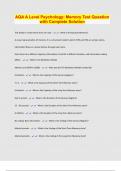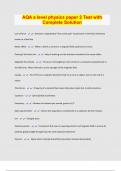Bestgrades9 Exams Shop
On this page, you find all documents, package deals, and flashcards offered by seller Bestgrades9
- 737
- 0
- 4
Community
- Followers
- Following
743 items

AQA A LEVEL TEXTILES PAPER 2 WITH COMPLETE SOLUTION 100% PASS
AQA A LEVEL TEXTILES PAPER 2 WITH COMPLETE SOLUTION 100% PASS User-Centered Design (UCD) - - developing new product according to what the consumers need or want. sometimes referred to as user driven development iterative design process - - a cycle of sampling, testing, analysing and refining a design until the final design is created quantitative data - - the factual info gathered form market research, it is often in numerical form and can be collected by measuring 'how many' research ...
- Exam (elaborations)
- • 9 pages •
AQA A LEVEL TEXTILES PAPER 2 WITH COMPLETE SOLUTION 100% PASS User-Centered Design (UCD) - - developing new product according to what the consumers need or want. sometimes referred to as user driven development iterative design process - - a cycle of sampling, testing, analysing and refining a design until the final design is created quantitative data - - the factual info gathered form market research, it is often in numerical form and can be collected by measuring 'how many' research ...

AQA A level sociology Paper 1 (Education) with Complete solution
AQA A level sociology Paper 1 (Education) with Complete solution Durkheim - - Social solidarity and specialist skills Parsons - - meritocracy Davis and Moore - - role allocation Chubb and Moe - - consumer choice Althusser - - Ideological state apparatus Bowles and Gintis - - Schooling in capitalist america Bowles and Gintis - - correspondence principle and hidden curriculum Willis - - Learning to labour McRobbie - - Bedroom culture McRobbie - - Impact of feminism. Magazine Study Shar...
- Exam (elaborations)
- • 2 pages •
AQA A level sociology Paper 1 (Education) with Complete solution Durkheim - - Social solidarity and specialist skills Parsons - - meritocracy Davis and Moore - - role allocation Chubb and Moe - - consumer choice Althusser - - Ideological state apparatus Bowles and Gintis - - Schooling in capitalist america Bowles and Gintis - - correspondence principle and hidden curriculum Willis - - Learning to labour McRobbie - - Bedroom culture McRobbie - - Impact of feminism. Magazine Study Shar...

AQA A LEVEL PSYCHOLOGY: BIOPSYCHOLOGY TEST WITH COMPLETE SOLUTION GRADED A+
AQA A LEVEL PSYCHOLOGY: BIOPSYCHOLOGY TEST WITH COMPLETE SOLUTION GRADED A+ Localisation of function - - Theory that states that different areas of the brain are responsible for different behaviours, processes or activities. Motor area - - Back of frontal lobe, involved in regulating movement. Somatosensory area - - Front of both parietal lobes, processes sensory information such as touch. Parts of the brain: Visual area. - - Occipital lobe, receives and processes visual information. Part...
- Exam (elaborations)
- • 10 pages •
AQA A LEVEL PSYCHOLOGY: BIOPSYCHOLOGY TEST WITH COMPLETE SOLUTION GRADED A+ Localisation of function - - Theory that states that different areas of the brain are responsible for different behaviours, processes or activities. Motor area - - Back of frontal lobe, involved in regulating movement. Somatosensory area - - Front of both parietal lobes, processes sensory information such as touch. Parts of the brain: Visual area. - - Occipital lobe, receives and processes visual information. Part...

AQA A LEVEL PSYCHOLOGY PAPER 2 with Complete Solution
approach. Compare to the biological approach, (classical conditioning) - - The idea of classical conditioning was developed by Pavlov who found that we learn through association. He found that it was possible to condition dogs to associate the sound of a bell with food. This resulted in the dogs producing a salivation response at the sound of a bell even when no food was present. Pavlov demonstrated that repeated exposure
- Exam (elaborations)
- • 9 pages •
approach. Compare to the biological approach, (classical conditioning) - - The idea of classical conditioning was developed by Pavlov who found that we learn through association. He found that it was possible to condition dogs to associate the sound of a bell with food. This resulted in the dogs producing a salivation response at the sound of a bell even when no food was present. Pavlov demonstrated that repeated exposure

AQA A Level Psychology: Memory Test Question with Complete Solution
AQA A Level Psychology: Memory Test Question with Complete Solution The ability to recall events from our lives - - What is the Episodic Memory? A visual representation of memory. It is a structural model in which STM and LTM are unitary stores. Information flows in a linear fashion through each store. Each store has a different capacity, information is held for a different duration, and information coding differs. - - What is The Multistore Model Atkinson and Shiffrin (1968) - - Who was ...
- Exam (elaborations)
- • 6 pages •
AQA A Level Psychology: Memory Test Question with Complete Solution The ability to recall events from our lives - - What is the Episodic Memory? A visual representation of memory. It is a structural model in which STM and LTM are unitary stores. Information flows in a linear fashion through each store. Each store has a different capacity, information is held for a different duration, and information coding differs. - - What is The Multistore Model Atkinson and Shiffrin (1968) - - Who was ...

AQA A level psychology – biopsychology Test with Complete Solution
AQA A level psychology – biopsychology Test with Complete Solution what is localisation of function? - - different parts of the brain are responsible for different things. Therefore, if brain damage occurs to just one area, only the functions linked to this area will be affected. what theory does localisation of function contrast? - - holistic - different areas of the brain work together. What is the case of Phineas Gage? - - 1) pole through left cheek passing behind his eye and exiting ...
- Exam (elaborations)
- • 31 pages •
AQA A level psychology – biopsychology Test with Complete Solution what is localisation of function? - - different parts of the brain are responsible for different things. Therefore, if brain damage occurs to just one area, only the functions linked to this area will be affected. what theory does localisation of function contrast? - - holistic - different areas of the brain work together. What is the case of Phineas Gage? - - 1) pole through left cheek passing behind his eye and exiting ...

AQA a level physics paper 2 Test with Complete Solution
AQA a level physics paper 2 Test with Complete Solution Line of force - - Direction a hypothetical "free north pole" would travel in the field. Otherwise known as a field line. Motor effect - - Effect in which a current in a magnetic field experiences a force. Fleming's left hand rule - - Way of working out the directions involved in the motor effect. Magnetic flux density - - Force per unit length per unit current on a conductor perpendicular to the field lines. Often referred to as t...
- Exam (elaborations)
- • 12 pages •
AQA a level physics paper 2 Test with Complete Solution Line of force - - Direction a hypothetical "free north pole" would travel in the field. Otherwise known as a field line. Motor effect - - Effect in which a current in a magnetic field experiences a force. Fleming's left hand rule - - Way of working out the directions involved in the motor effect. Magnetic flux density - - Force per unit length per unit current on a conductor perpendicular to the field lines. Often referred to as t...

AQA A LEVEL PHYSICS PAPER 1 TEST WITH COMPLETE SOLUTION
AQA A LEVEL PHYSICS PAPER 1 TEST WITH COMPLETE SOLUTION What is meant by work function (2) - - Minimum energy required by an electron to escape from (1) a metal surface (1) What is meant by ionisation energy? (2) - - Minimum energy required to remove an electron from an atom (1) from the ground state (1) Why do emitted electrons have a kinetic energy that varies up to a maximum value? (4) - - Energy of a photon is fixed/constant (1) Energy is required for electrons to overcome work funct...
- Exam (elaborations)
- • 7 pages •
AQA A LEVEL PHYSICS PAPER 1 TEST WITH COMPLETE SOLUTION What is meant by work function (2) - - Minimum energy required by an electron to escape from (1) a metal surface (1) What is meant by ionisation energy? (2) - - Minimum energy required to remove an electron from an atom (1) from the ground state (1) Why do emitted electrons have a kinetic energy that varies up to a maximum value? (4) - - Energy of a photon is fixed/constant (1) Energy is required for electrons to overcome work funct...

AQA A LEVEL PHYSICS PAPER 1 EXAM TEST WITH COMPLETE SOLUTION 100% PASS!!
AQA A LEVEL PHYSICS PAPER 1 EXAM TEST WITH COMPLETE SOLUTION 100% PASS!! What is meant by work function (2) - - Minimum energy required by an electron to escape from (1) a metal surface (1) What is meant by ionisation energy? (2) - - Minimum energy required to remove an electron from an atom (1) from the ground state (1) Why do emitted electrons have a kinetic energy that varies up to a maximum value? (4) - - Energy of a photon is fixed/constant (1) Energy is required for electrons to ov...
- Exam (elaborations)
- • 7 pages •
AQA A LEVEL PHYSICS PAPER 1 EXAM TEST WITH COMPLETE SOLUTION 100% PASS!! What is meant by work function (2) - - Minimum energy required by an electron to escape from (1) a metal surface (1) What is meant by ionisation energy? (2) - - Minimum energy required to remove an electron from an atom (1) from the ground state (1) Why do emitted electrons have a kinetic energy that varies up to a maximum value? (4) - - Energy of a photon is fixed/constant (1) Energy is required for electrons to ov...

AQA A Level PE with Complete Solution
ry and the government. Also work with other national organisations. Whole sport plans Aim to nurture/ develop talent. Ensure real opportunities for communities. Have a role protecting sports provisions. 19th Century Amateurism - - Dominant force in sport in nineteenth-century Established in Public schools From elite social classes (Upper
- Exam (elaborations)
- • 63 pages •
ry and the government. Also work with other national organisations. Whole sport plans Aim to nurture/ develop talent. Ensure real opportunities for communities. Have a role protecting sports provisions. 19th Century Amateurism - - Dominant force in sport in nineteenth-century Established in Public schools From elite social classes (Upper
